Bayer R.G. Mechanical Wear Fundamentals and Testing, Revised and Expanded
Подождите немного. Документ загружается.


chip formation. Repeated-cycle deformation wear results from the accumulation of plastic
strain associated with the stress cycle, culminating in progressive plastic deformation,
crack formation, and crack propagation.
This consideration of hysteretic friction points out a significant aspect of friction,
namely that it results in the dissipation of energy. The energy associ ated with friction is
dissipated in two general ways. The vast majority of the energy is dissipated as heat
(3–5). A much smaller amount is associated with material loss or deformation, that is,
wear. Most estimates indicate that well over 90% of the energy dissipated in friction goes
in the form of heat energy.
Models have been proposed for these friction mechanisms but are typically limited
in applicability. Generally, all of the models indicate a more complex situation than indi-
cated by the postulations of da Vinci and Amontons (ca. 1500 and 1700, respectively)
which frequently are used in engineering. These statements, commonly referred to as
Amontons’ Laws of Friction, may be summarized as: (1) the friction force is propor-
tional to the normal load, (2) the friction force is independent of the apparent area of
contact. The current models, as well as experimental data, indicate that these conclu-
sions should be viewed as approximations with a limited range of applicability. This
view can be illustrated by the consideration of some simple models for friction force
and the coefficient of friction and some examples of observed behavior. For simplicity,
only dry or unlubricated surfaces will be considered at this point. Friction behavior
under lubricated conditions will be discussed in the section on lubrication. A model used
for paper can be used as a way of illustrating these general models (6).
For adhesion, the general concept is that the F
ad
is given by
F
ad
¼ sA
r
ð5:4Þ
where s is the shear strength of the junctions, and A
r
is the real area of contact (7). s is a
property of the material system at the interface and is influenced by the same parameters
as discussed for adhesive wear (e.g., oxides, cleanliness of the surface, solubility, material
strength properties). As was discussed in the sections on wear, A
r
can be affected by mate-
rial properties, asperity distribution, and contact geometry. For example, in the case of a
sphere pressed against a plane, a general relationship for A
r
is of the following form:
A
r
¼ CR
n
P
m
ð5:5Þ
where C is a material parameter, R is the radius of the sphere, and P is the normal load
(8,9). The exponents, n and m, are positive and depend on both the nature of the stress
system at the junctions and the asperity distribution. For plastic deformation, n ¼ 0
and m ¼ 1. For elastic deformation, n > 0 and m is between 0 and 1 for relatively simple
asperity distributions but can be greater than 1 for some complex asperity distributions.
The expression for the coefficient of friction then has the following form:
m
ad
¼ K
ad
R
n
P
m1
ð5:6Þ
where C and s are combined into K
ad
. Implicit in this relationship is the additional depen-
dencies on load and other parameters as a result of their ability to influence tribosurfaces.
These would be contained in K
ad
.
Abrasive fric tion can be illustrated by considering a cone of included angle F plowing
through a softer surface. For plastic deformation, the force required to do this, F
0
, is given by
F
0
¼
cot FP
0
p
ð5:7Þ
Copyright 2004 by Marcel Dekker, Inc. All Rights Reserved.

where P
0
is the load on that asperity. For an array of such asperities supporting a total load,
P, F
ab
can be expressed as
F
ab
¼ K
ab
cot F P ð5:8Þ
where
K
ab
cot F P p
1
X
cot F
i
P
i
ð5:9Þ
In this expression,
cot F reflects the average sharpness of the asperities, while
K
ab
is the parameter accounting for the complete description of the asperity distribu-
tion. The coefficient of friction is then
m
ab
¼ K
ab
cot F ð5:10Þ
If the cone produced only elastic deformation, there would still be a friction force
and the form of the expression for the coefficient of friction would be similar. However,
in this case, the friction force would be generated by hysteresis. Equation (5.10) would be
modified by a factor e, which is the ratio of the energy lost to the energy required for the
deformation (10). This similarity of form implies that Eq. (5.10) is also appropriate
for more realistic material behavior, where the deformation contains both an elastic
and plastic portion.
Hysteresis can also be associated with the stress system associated with the macro-
geometry of the contact. In this case, the coefficient of friction is proportional to the stress
level (11). In the elastic co ntact between a sphere and a plane, the stress level is propor-
tional to the P
1=3
and inversely proportional to R
2=3
, where R is radius of the sphere.
The friction force, F
hys
, would be
F
hys
¼ K
hys
P
4=3
R
2=3
ð5:11Þ
and the coefficient of friction would be
m
hys
¼ K
hys
P
1=3
R
2=3
ð5:12Þ
Assume that a fraction of the load, a, is supported by junctions at which adhesion
takes place and the remaining fraction by junctions at which deformation occurs, that is
by adhesion and single-cycle deformation, respectively. For such a situation, the general
expression for the coefficient of friction for a rough sphere sliding on a plane is
m ¼ K
ad
a
m
P
m1
R
n
þ K
ab
cot F 1 aðÞþK
hys
P
1=3
R
2=3
ð5:13Þ
The observed behavior of the coefficient friction between hardened steel and sheets
of paper, supported by a steel platen, shows the same type of dependencies indicated by
this equation. These data are shown in Figs. (5.3–5.5). These data show the coefficient
of friction to be dependent on the roughness of the sphere, the radius of the sphere, and
the normal load. However, the relationships appear more complex than indicated by
Eq. (5.13). A dependency on paper thickne ss is also evident, which modifies the influ-
ence of load and radius. This effect can be attributed to the influence that the thickness
of the paper layer has on the nature of the stress system developed in the paper. The
thinner the paper layer , the greater is its apparent stiffness. This is analogous to the
behavior for friction of a layered metallic surface (12,13).
The simple models for the abrasion and adhesion compo nents of friction imply that
under rolling their effects should be eliminated (14). Consequently, rolling friction tests
Copyright 2004 by Marcel Dekker, Inc. All Rights Reserved.
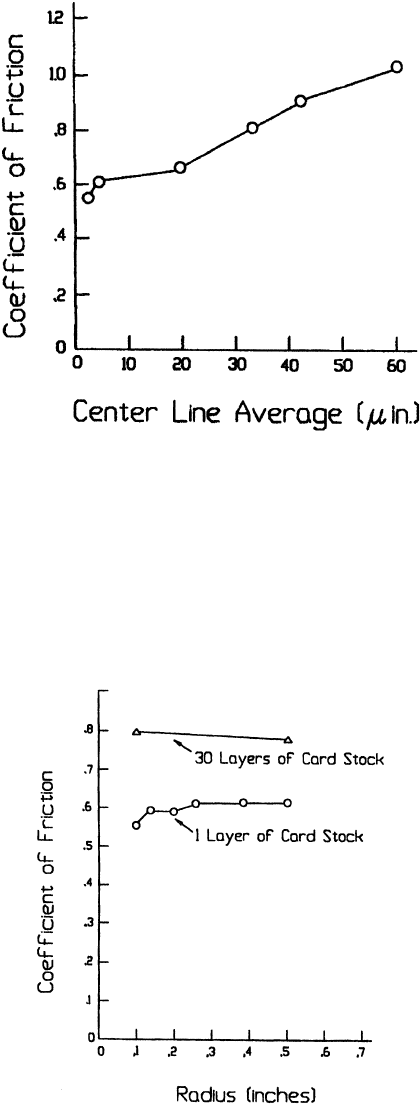
were conducted to estimate the significance of hysteresis in the overall behavior and the
results are shown in Fig. 5.6. It can be seen that while a significant load dependency is indi-
cated that is somewhat stronger than that suggested by Eq. (5.13), actual friction is much
lower than for sliding. This suggests that the major contributors to the sliding friction for
this system are adhesion and abrasion. Furthermore, the actual data suggest that m and n
Figure 5.3 Influence of roughness on the coefficient of friction for sliding between steel and paper.
(From Ref. 6.)
Figure 5.4 Influence of the radius of a steel slider on the coefficient of friction for sliding between
steel and paper. (From Ref. 6.)
Copyright 2004 by Marcel Dekker, Inc. All Rights Reserved.
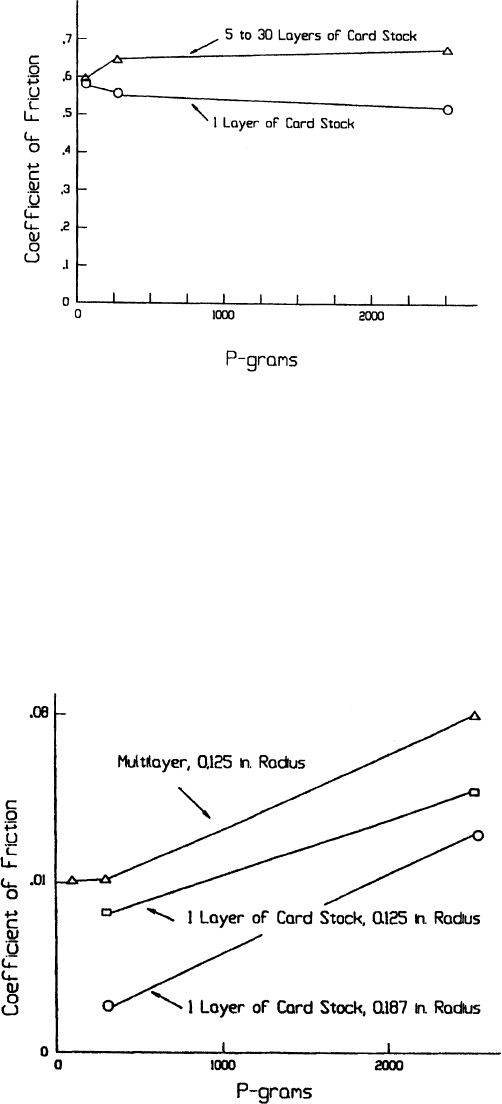
of Eq. (5.6) are close to 1 and 0, respectively. The data also show that size is a significant
factor.
While this example of frictional behavior indicates that load and geometry can influ-
ence friction, it also shows that Amontons’ Laws are also approximately followed, that is,
the coefficient of friction is independent of load and geometry. At least over limited
ranges, this situation is true for most material systems, especially those that exhibit low
hysteresis. This would include metals, ceramics, and the more rigid polymers or plastics.
Figure 5.5 Influence of load on the coefficient of friction for sliding between steel and paper.
(From Ref. 6.)
Figure 5.6 Influence of load on the coefficient of friction for rolling between a steel sphere and
paper. (From Ref. 6.)
Copyright 2004 by Marcel Dekker, Inc. All Rights Reserved.
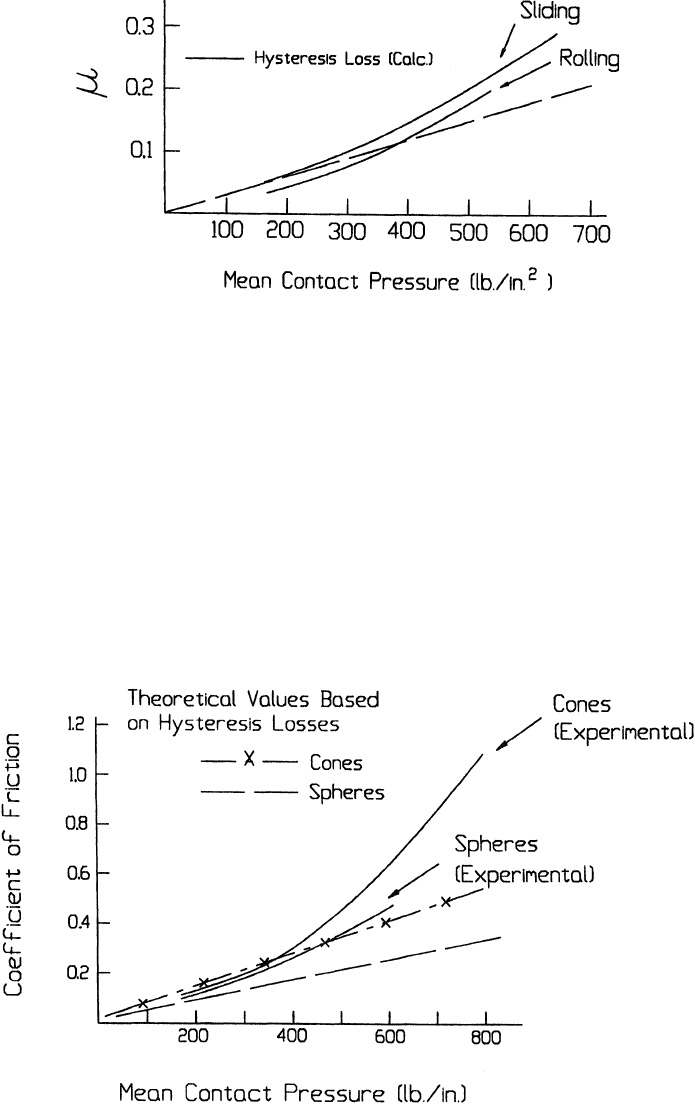
Materials, which tend to exhibit high hysteresis, such as rubbers or elastomers, usually
exhibit a greater effect of load and geometry on the coefficient of friction. Examples of this
behavior are shown in Figs. 5.7 and 5.8.
While the above is generally true, there are examples in which load and geometry
significantly influence friction, independent of a hysteretic effect. Sliding over a woven
surface provides an example of the influence of geometry and load. Data for such a
situation are shown in Fig. 5.9. Metallic and ceramic sliding systems can also show an
influence of load on the coefficient of friction. This is generally related to the relationship
between oxide formation and sliding parameters (15,16). The coefficient of friction for
unlubricated, self-mated copper is shown in Fig. 5.10 as a function of load. Two regimes
Figure 5.7 Coefficients of friction for sliding and rolling between a steel sphere and a well-lubri-
cated rubber surface. (From Ref. 26.)
Figure 5.8 Coefficients of friction for spheres and cones sliding on lubricated rubber. (From
Ref. 26.)
Copyright 2004 by Marcel Dekker, Inc. All Rights Reserved.
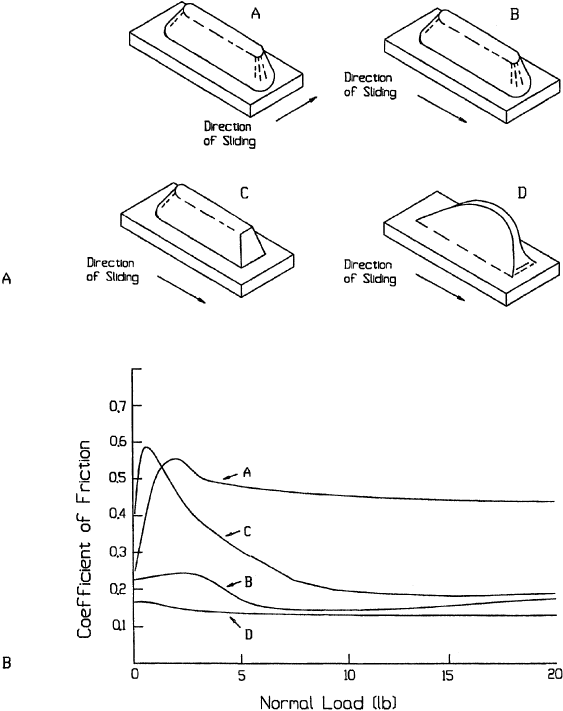
of friction behavior are evident as function of load. In each, the coefficient of friction is
independent of load, indicating that within those regimes Amontons’ Law is applicable.
In this particular case, the form ation of different oxides in the two regions is the expla-
nation for this behavior. This is also an example of a transition in friction behavior as a
result of tribosurface modification, similar to the transitions in wear behavior.
As shown by the development of Eq. (5.13), roughness can influence the coefficient
of friction through abrasive and hysteresis effects (17). In addition, roughness can affect
friction behavior through the adhesive mechanisms. In fact, this can be a stronger or more
pronounced effect than those associated with the other two mechanisms, tending to
increase the coefficient of friction, as surfaces become smoother. The coefficient of friction
for clean, self-mated copper surfaces is shown in Fig. 5.10 as a function of roughness. It
can be seen that friction increases much more rapidly for smoother surfaces than it does
for rougher surfa ces. The explanation for this is that as the surfaces become smoother, the
real area increases rapidly and tends to become independent of the load. Perfectly smooth,
flat surfaces result in the real area of contact being equal to the apparent area. Under these
Figure 5.9 Variations of the coefficient of friction for sliding between steel and a lubricated fabric
with different steel geometries. (From Ref. 27.)
Copyright 2004 by Marcel Dekker, Inc. All Rights Reserved.
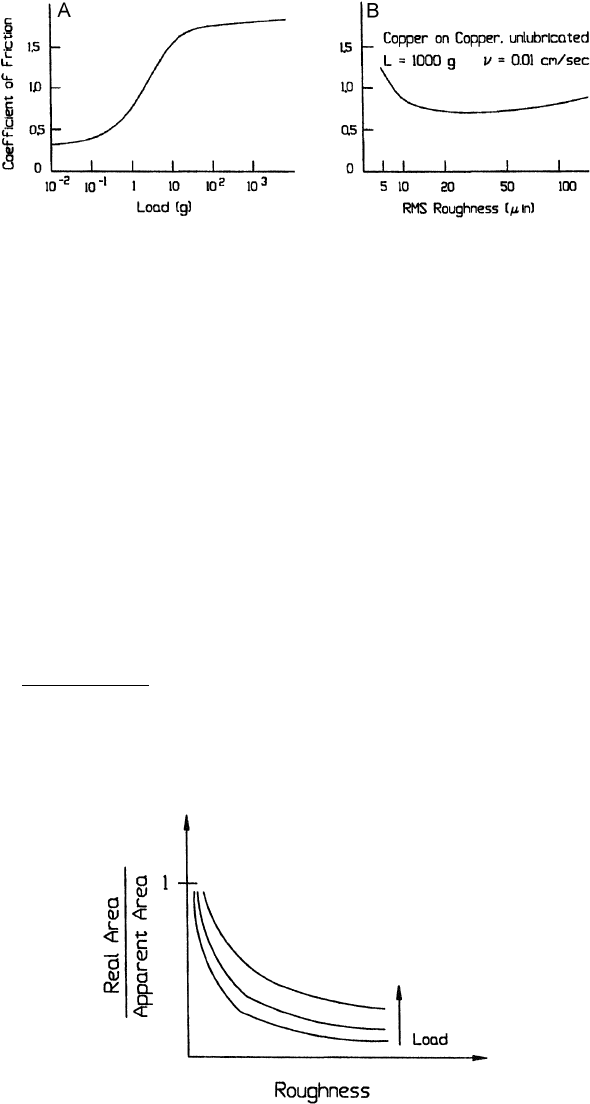
conditions, adhesion can be extremely large, with the contact being one large junction.
Consequently, there would be a significant increase in the adhesion term, as the surfaces
become smoother. This concept is illustrated in Fig. 5.11.
In the case of rubber, smooth surfaces also introduce additional aspects to friction.
With rubbers, Schall amach waves or waves of detachment occur and can be the prim ary
contributor to the friction between rubber or elastomers and smooth surfaces (5,18).
Fig. 5.12 illustrates this. In this situation, there is strong local adhesion between the rubber
surface and the counterface. As sliding occurs, local regions remain attached, at least up to
a certain point. Then the bond is broken and the rubber snaps forward. At some point, it
again adheres and the process repeats. This process can be viewed as waves, which propa-
gate across the rubber surface. Examinations of sliding contacts and wear scar morphology
suggest this behavior as well. This is shown by the examples in Fig. 5.13. In this case, the
friction force is associa ted with adhesion as well as with hysteresis losses in the stretch-
ing of the rubber. The following equation has been proposed for this mechanism (5):
m ¼
2G
s½ 2=e
t
ðÞþ1
1=2
ð5:14Þ
where e
t
is the compressive strain; G, the loss portion of the complex shear modulus;
and s
ij
the mean pressure.
Figure 5.10 Coefficient of friction for unlubricated sliding between Cu surfaces. (‘‘A’’ from Ref.
28; ‘‘B’’ from Ref. 29.)
Figure 5.11 Changes in the ratio of the real and apparent areas of contact as a function of load and
roughness.
Copyright 2004 by Marcel Dekker, Inc. All Rights Reserved.
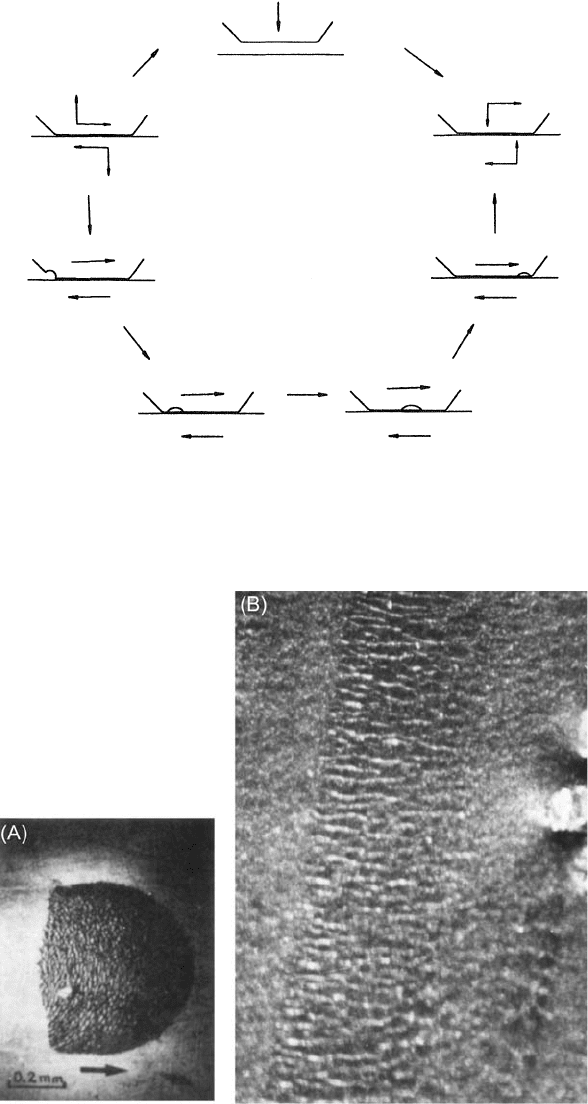
Figure 5.12 Illustration of the propagation of Schallamach waves across a rubber surface (trun-
cated cone in figure) during sliding on a flat surface. (From Ref. 18.)
Figure 5.13 Examples of the wave-like wear scar morphology frequently observed on elastomer
surfaces as a result of sliding. (‘‘A’’ from Ref. 30, reprinted with permission from ASTM.)
Copyright 2004 by Marcel Dekker, Inc. All Rights Reserved.
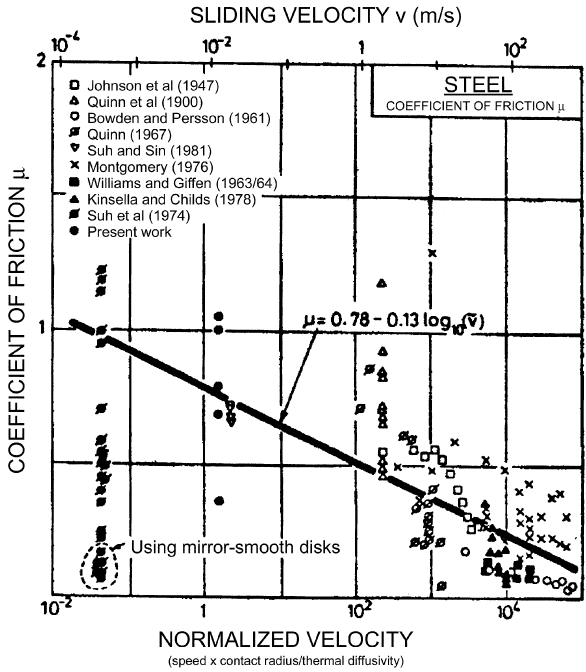
While the simple models used to describe the mechanisms associated with friction
do not explicitly indicate a dependency on sliding velocity, most systems exhibit some
velocity effect. The effect is relatively mild for most engineering materials as changes
of several orders of magnitude in sliding velocity might result in less than a factor of
2 change in friction. An example is shown in Fig. 5.14. In this figure, the coefficient
of friction for unlubricated sliding between steel surfaces is plotted as a function of
speed. There can be several reasons for a dependency on speed and the specific reason
is usually related to the material or materials involved. For material s, which exhibit
creep, such as soft metals and polymers, it is usually associated with viscoelastic beha-
vior of such materials. For such materials, friction usually achieves a maximum value in
a particular range of velocity. For other types of materials, friction generally tends to
decrease with sliding. Melting and softening at higher speeds can also be a factor, as
in the case with polymers, and oxide formation can be a factor in metal systems, as
is the case with the data shown in Fig. 5.15. Junction growth phenomena can also con-
tribute to this decrease in friction. This is because junction size tends to increase with
time under shear (19). There will be less time for growth at higher sliding speeds. Smaller
Figure 5.14 Variation in the coefficient of friction with sliding velocity for unlubricated steel.
(From Ref. 31, reprinted with permission from Elsevier Science Publishers.)
Copyright 2004 by Marcel Dekker, Inc. All Rights Reserved.
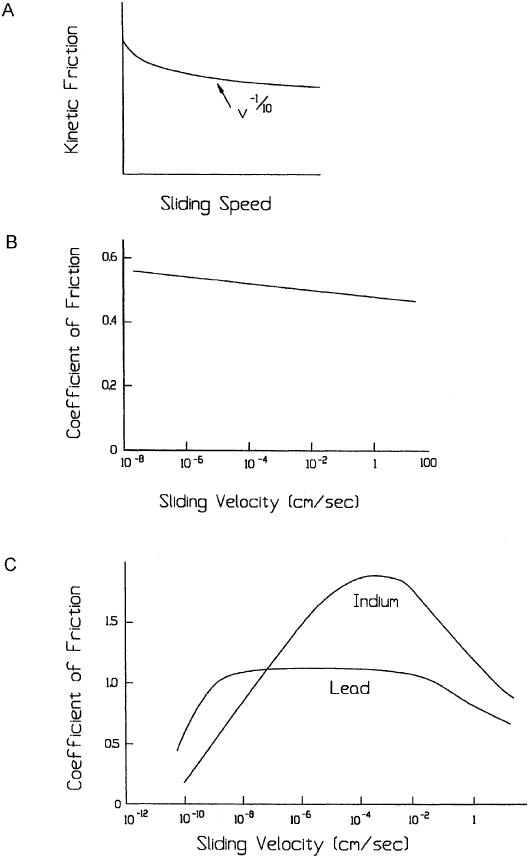
junctions result in less real area of contact and a lower adhesion contribution to friction.
The graphs in Fig. 5.15 show some examples of this type of behavior.
Because of the adhesive component of friction, friction behavior is very sensitive to
surface film and layer s, particularly in unlubricated situations. The effect of oxide for-
mation on the coefficient of friction and the effect of humidity illustrate this. Another
example is surface contamination from handling or exposure to contaminating environ-
ments. With metals, this can often reduce the coefficient of fri ction from a value near
1 to 0.3–0.6.
Figure 5.15 Effects of sliding speed on the coefficient of friction for several systems. ‘‘A’’, general
trend; ‘‘B’’, Ti=Ti unlubricated; and ‘‘C’’, steel against Pd and In. (From Ref. 31.)
Copyright 2004 by Marcel Dekker, Inc. All Rights Reserved.
